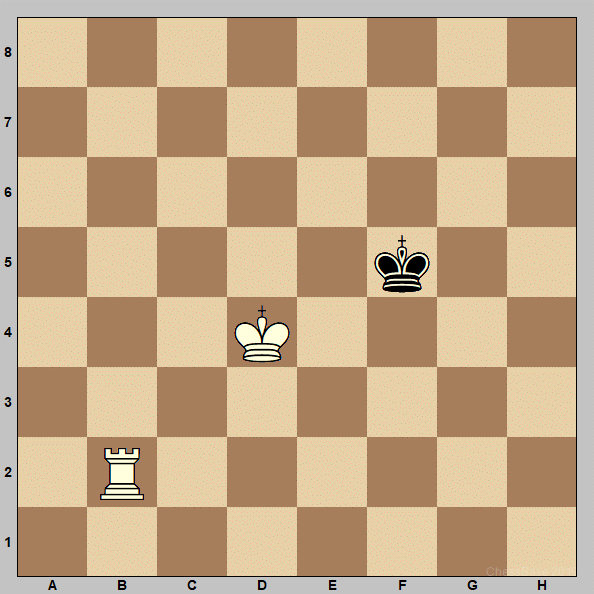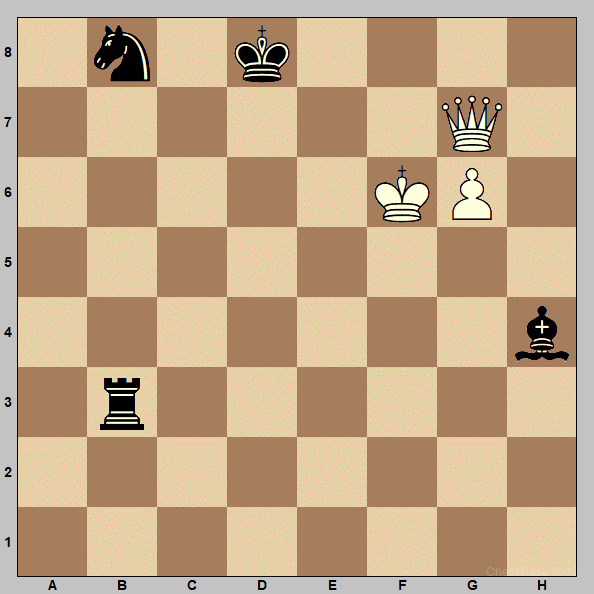 A chess endgame is the closing part of a game of chess that typically comes after the middle game. However, the transition from middle game into endgame may be either very gradual and not clear at all, or just the opposite after massive exchanges of pawns and pieces. Indeed, there are not too many pawns and pieces left on the board during the ending phase of the game which simplifies analysis in certain types of endgame positions whereas in others may be still very complex at least for a human player. Strategic concerns are very different in the endgame as opposed to the middle game and opening. Among others, pawns are much more important as they often stand a real chance to get promoted to a queen which would usually decide the game. Interestingly, the king becomes a strong piece in the endgame oftentimes fighting actively in the center of the board or helping mate the oponent's king (see diagram).
A chess endgame is the closing part of a game of chess that typically comes after the middle game. However, the transition from middle game into endgame may be either very gradual and not clear at all, or just the opposite after massive exchanges of pawns and pieces. Indeed, there are not too many pawns and pieces left on the board during the ending phase of the game which simplifies analysis in certain types of endgame positions whereas in others may be still very complex at least for a human player. Strategic concerns are very different in the endgame as opposed to the middle game and opening. Among others, pawns are much more important as they often stand a real chance to get promoted to a queen which would usually decide the game. Interestingly, the king becomes a strong piece in the endgame oftentimes fighting actively in the center of the board or helping mate the oponent's king (see diagram).
!!! THE GOLDEN RULE OF CHESS ENDGAME !!!
| As a rule of thumb, the stronger side, i.e. the one enjoying material advantage, should exchange pieces (knights, bishops, rooks and queens) and avoid exchanging pawns!!! The defending side should strive to do just the opposite!!! |
Endgames can be divided into several categories depending on what pieces have been left on the board, and also on their statistical application in practical play:
- Basic checkmates
-
King and pawn endings
-
Knight and pawn endings
-
Bishop and pawn endings
-
Bishop versus knight endings (with pawns)
-
Rook and pawn endings
-
Queen and pawn endings
-
Rook versus a minor piece
-
Two minor pieces versus a rook
-
Queen versus two rooks
-
Queen versus rook and minor piece
-
Piece versus pawns
-
Endings with no pawns
Endgame tablebases
Computerized databases of chess endgames are called "Endgame tablebases" in chess lingo. They contain precalculated endgame positions whose exhaustive analysis provides an unambiguous outcome (win, loss or draw), how many moves are required to achieve the outcome result as well as the optimal move possible in a certain position. Endgame tablebases are typically used by chess engines to improve and speed up their performance in chess ending analysis. Tablebases are generated by retrograde analysis which means working backward from a checkmated endgame position.
By 2005, all chess positions with up to six pieces (including the two kings) had been solved. By August 2012, tablebases had solved chess for every position with up to seven pieces (the positions with a lone king versus a king and five pieces were omitted because they were considered to be "rather obvious", Wikipedia). Many famous mathematicians and computer programmers have worked on solving computer endgames, among others Ken Thompson, Eugene Nalimov, Ronald de Man who has created Syzygy tablebases, as well as Vladimir Makhnychev and Victor Zakharov of Moscow State University Research Computing Center who used a superpower computer Lomonosov (78,660 cores; 99,489 GB RAM) to do the job of solving all 7-man endgames (2 kings + 5 chessmen). As you can guess such an extensive database of chess endgame positions requires a lot of disk space. The Lomonosov tablebases contain the exact evaluations (draw or moves to mate) for all positions with no more than 7 chessmen on the board. The total number of positions in the tables is more than 500 trillions (500 000 billions). The real number of similar positions is several times more, but part of them can be obtained from others by mirroring and rotating of the board, so there is no need to keep them on disks.
The below table summarizing the current status of chess endgame analysis may well give you an idea of how demanding it can be (after Wikipedia).
| No. of pieces | Number of positions | Database name | Disk space |
| 2 | 462 | Syzygy | (included in the 5-piece tablebase) |
| 3 | 368,079 | Syzygy | (included in the 5-piece tablebase) |
| 4 | 125,246,598 | Syzygy | (included in the 5-piece tablebase) |
| 5 | 25,912,594,054 | Syzygy | 939 MB |
| 6 | 3,787,154,440,416 | Syzygy | 149.2 GB |
| 7 | 423,836,835,667,331 | Syzygy | 16.7 TB |
| 7 | 423,836,835,667,331 | Lomonosov | 100 TB |
| 8 | 38,176,306,877,748,245 | N/A (work in progress) | 1 PB (1000 TB) |
![]() !!! THE MATE IN 549 CHALLENGE !!!
!!! THE MATE IN 549 CHALLENGE !!! ![]()
| The longest 7-piece mate as evaluated by Lomonosov tablebases comprises 549 optimal moves for both sides (see diagram below). Just go figure!!! If you wanna kill some time, feel free to go analyze it yourself! |
 [Event "Lomonosov Tablebases"]
[Event "Lomonosov Tablebases"]
[Site "Computer Science Department of Moscow State University"]
[Date "August, 2012"]
[Round "1"]
[White "Lomonosov"]
[Black "Lomonosov"]
[Result "1-0"]
[SetUp "1"]
[FEN "1n1k4/6Q1/5KP1/8/7b/1r6/8/8 w - -"]
You may wanna copy & paste FEN into your favorite chess engine for analysis.
White to move and win! Do you think you could solve the above Mate in 549 moves?! If you are brave enough to challenge yourself please keep it in mind that there is only one move winning for White in this position! ![]()
![]()
You can check your solution by clicking the link below. The complete notation showing off all of the moves is also presented there.



